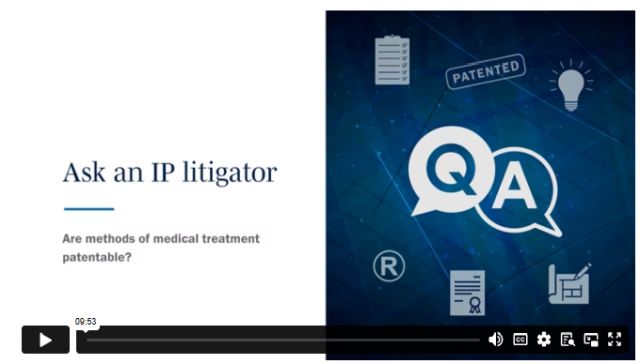- within Intellectual Property topic(s)
- with Finance and Tax Executives and Inhouse Counsel
- in European Union
- with readers working within the Healthcare, Retail & Leisure and Law Firm industries
- with Inhouse Counsel
- with readers working within the Healthcare, Retail & Leisure and Law Firm industries
Video transcript
Yael Bienenstock (00:05): Hello everyone, and welcome to another session of Ask an IP Litigator. Today we're going to talk about one of the more confusing aspects of patent law, which is the idea that so-called "methods of medical treatment" are not patentable. Now, you might be thinking: "Methods of medical treatment? That sounds pretty broad". What's included in that bucket of unpatentable things?
And you would be right to be confused. In fact, courts have been grappling with this idea for decades, and the law still struggles to be coherent. But this October, the Supreme Court of Canada is going to hear the Pharmascience and Janssen case, a case about methods of medical treatment, where it will hopefully clarify the law in this area.
So, Alex, how did we get here? Who came up with this idea in the first place?
Alex Peterson (00:49): So the idea that methods of medical treatment are unpatentable subject matter goes back to a 1974 decision of the Supreme Court called Tennessee Eastman. That case related to a surgical adhesive, or more specifically, an attempt to obtain a patent claiming a method for applying a kind of surgical glue to bond tissues. The question was whether the use of this adhesive, which was already a known substance in this method of surgical treatment, could be patented.
At the time, there was a prohibition in the Patent Act, section 41(1) on patenting substances intended for food or medicine, unless the claims were directed to the substance when made by a particular process or method. So, in other words, you couldn't obtain a claim to a substance intended for food or medicine itself. You could only obtain what are termed "product by process claims".
The Supreme Court in Tennessee Eastman concluded that the claims in question were unpatentable because they would allow a patentee to claim a substance intended for medicine however it was made, simply by claiming its therapeutic use, thereby avoiding the application of section 41(1).
Eventually, section 41 of the Patent Act was repealed, but subsequent decisions of the Supreme Court continued to say that methods of medical treatment were unpatentable because they related to the skill and judgement of a professional and were essentially non-economic and unrelated to trade and commerce, even though the Supreme Court's decision in Tennessee Eastman wasn't really based on that point.
And as others have pointed out, the idea that the exercise of professional skill and judgement is inherently non-economic is a pretty shaky rationale for the exclusion of methods of medical treatment from patentable subject matter. Subsequently, decisions of the Federal Court and Federal Court of Appeal continue to apply this principle, essentially developing it to a question of whether the claim was to a "vendible product" which has economic value and is patentable, or whether the claim encompasses the skilled work of a physician, which is unpatentable.
So that's the policy rationale for this. But my impression is that its application has been difficult. Yael, why is that?
Yael Bienenstock (02:59): Well, hearing you talk, it seems self-evident. It's awfully confusing. So just to reiterate the test that the federal courts came up with to tell what's patentable and what's not: they said a vendible product is patentable, and something that requires the exercise of skill and judgement is not. That's the dichotomy that is essentially set up in the case law.
And there are a couple of problems with this. The first one is it doesn't map very nicely onto the Patent Act. And if we set aside the now-repealed section 41, then the statutory basis for this prohibition on patenting methods of medical treatment has to come from section 2 of the Patent Act, which sets out the definition of invention.
And it says that an invention is, "any new and useful art process, machine, manufacture or composition of matter", or any new and useful improvement in any of these. None of that talks about vendible product versus skill and judgement. So that's difficulty number one. The fact that a "process" is included makes it even more complicated, because it's hard to say that only a vendible product is patentable, because a vendible product sounds like it has to be a thing, and it can't be a process, but a process is set out in the Act as something that's patentable.
The second problem is this doesn't map very well onto patent law generally, because it is clear, and courts have held, that you can patent the use of drug X for the treatment of condition Y. And courts say, "well, this is a vendible product", but that's not super intuitive.
And of course, whenever a doctor decides to use drug X for the treatment of condition Y, what are they doing? Well, they're, I think, exercising their skill and judgement. So when it comes to applying the test, how do you tell if something is an impermissible method of medical treatment or a permissible use claim? And courts have really struggled with this.
And that's led to the development of some principles that I think everyone continues to struggle to understand and apply. When it comes to dosing regimens, courts have said if the claim encompasses a dosage range, then it's not patentable subject matter. It's an unpatentable method of medical treatment. But if you claim a fixed dosage, that's fine. It's unclear why there's that distinction.
And if you claim the use of drug X for the treatment of condition Y with no dosage, that's also okay. So is it when you claim an effective amount of drug X to treat condition Y. And so everyone—lawyers, clients, courts—struggle to understand the principled basis for these distinctions. And so courts and commentators have been essentially asking the Supreme Court of Canada to take this up and fix all of this.
And that's exactly what might happen in the Pharmascience and Janssen case. So that case is a case about a dosing regimen. There's a couple of different parts to the regimen. But the claims talk about fixed dosages. In the product monograph, the product monograph sets out a dosage range for the maintenance dose, which is one of the aspects of the regimen.
And everyone agrees that choosing the right dose within that range is a matter of skill and judgement. But the federal court said—this is the case below—that since the claims did not claim ranges, they claimed fixed dosages, going back on the law that I just talked about, they're not invalid for methods of medical treatment. They're okay.
The Federal Court of Appeal agrees, and the Federal Court of Appeal tried to put a little bit of principle behind it. They said skill and judgement on whether to use the invention is allowed. So if you—a doctor decides, you know, I'm going to use or not use the fixed dosage in the claim, that's the kind of skill and judgement that's okay, because they're not using their skill and judgement on how to use the invention. But then the court went on to say, "we can't really give future parties or courts much guidance about this", which, again, seems to be a bit of a call for the Supreme Court of Canada to take this up.
And so the Supreme Court of Canada has answered that plea. And as we said, is going to be hearing this matter in October.
So what do you think, Alex? Is the Supreme Court going to fix all this, are we going to get the detailed guidance that the Federal Court of Appeal has been asking for in the case law?
Alex Peterson (07:08): Well, it's difficult to say. On the one hand, I think it's very clear from the comments of the Federal Court of Appeal on more than one occasion, that the current framing of the test for when something would be considered an unpatentable method of medical treatment with respect to drug dosing regimens is incoherent. And I think even Pharmascience in their factum agrees that the jurisprudence on what constitutes a method of medical treatment is inconsistent and confusing.
So there's a world where the Supreme Court maintains the general exclusion of methods of medical treatment from patentable subject matter, but attempts to reconcile or fix the incoherency in the case law and articulate a test that can be more easily understood and applied going forward. The problem is that that incoherency and difficulty articulating a test that makes sense seems to be the reason that the case has made its way to the Supreme Court in the first place.
That said, both parties have tried to propose alternatives, but it's not clear that either Pharmascience's proposed test or Janssen's proposed test are going to provide a coherent, sound and easily-applied basis to determine whether any given claim stands or falls as an unpatentable method of medical treatment.
So there's a world where the Supreme Court decides that this prohibition on methods of medical treatment is unsound, and that there's no reason to distinguish these claims from other forms of patentable pharmaceutical innovation, provided that the other requirements of the Patent Act are met. They could do away with this exclusion entirely and leave it to the legislature to implement an exclusion if this is something Parliament still sees as problematic. Really, we'll have to wait and see how the Court reacts to both the parties and the intervenor arguments in October, which is the current tentative date for the hearing of this case.
So what do you think? Do you agree?
Yael Bienenstock (08:50): I totally agree that we're going to have to wait and see. You never know what the Supreme Court of Canada is going to do. I hope that the Court will come back to the statutory basis, if any, for this prohibition. The Court has said multiple times the patent law is statutory, and hopefully they will reiterate that. And now that we don't have section 41, hopefully we'll see a deep dive on patentable subject matter under section 2 of the Act.
You know, hopefully the Court is going to focus the analysis on how do you tell if something is an art, process, machine, manufacture or composition of matter? If it falls into one of those categories, it should be patentable subject matter. That, I think—I don't know if that's what the parties have advocated as the test, but it sounds like possibly not.
But I certainly hope that we see a move away from buzzwords like "vendible product" and "physician skill and judgement" because nobody really seems to know what these words mean. So everybody, we look forward to talking about this decision after it comes out in October.
The question of whether "methods of medical treatment" are patentable has long been a matter of debate.
In this video, Yael Bienenstock and Alex Peterson break down the historical reasoning behind this concept, and discuss:
- The history behind the SCC's 1974 decision in Tennessee Eastman
- The difficulty in applying the Patent Act's definition of "vendible product" to methods of medical treatment
- The issues at play in an upcoming Supreme Court hearing that might help clarify the law in this area.
Click here to see other videos in this series.
The content of this article is intended to provide a general guide to the subject matter. Specialist advice should be sought about your specific circumstances.



